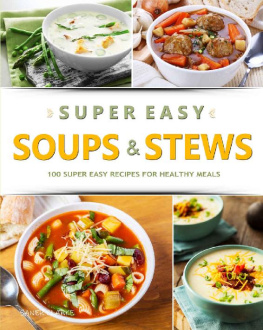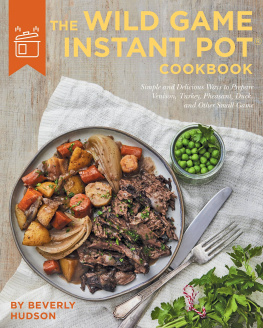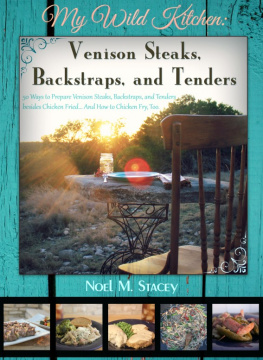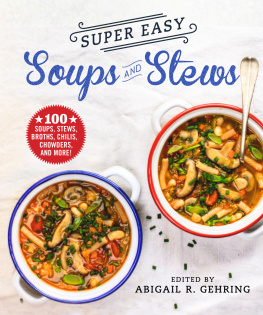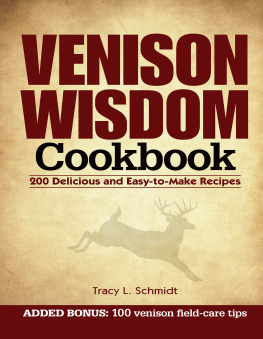ACKNOWLEDGMENTS

The author would like to acknowledge recipes adapted from The Art of American Indian Cooking by Yeffe Kimball and Jean Anderson, copyright 1965, reprinted by the permission of McIntosh & Otis, Inc.; material from the article Dont Stew over Venison, reprinted courtesy of Southern Outdoors Magazine and B.A.S.S. Inc.; material from The Official Louisiana Seafood & Wild Game Cookbook , reprinted with permission from the State of Louisiana Department of Wildlife and Fisheries; brief quotations from The Complete Book of Outdoor Cookery by James A. Beard and Helen Evans Brown, reprinted by permission of HarperCollins Publishers; a recipe reprinted from Alaska Magazines Cabin Cookbook by permission of Alaska magazine; a recipe from Cracklin Bread and Asfidity: Folk Recipes and Remedies , compiled by Jack Solomon and Olivia Pienezza Solomon, copyright 1979, used by permission of the University of Alabama Press; a recipe from The Maine Way , published by the Maine Department of Inland Fisheries and Wildlife; material from Wildlife Cookbook , published by the North Carolina Wildlife Resources Commission; and a recipe from Cooking the Sportsmans Harvest II , published by the South Dakota Department of Game, Fish, and Parks.
Appendix A

TEN STEPS TO BETTER VENISON
A s I tried to make clear in the introduction, having a good venison recipe and knowing how to cook it guarantee nothing. The cook simply must have good meat to work with, no matter whether he is cooking beef, pork, or venison. Back when farmers butchered their own hogs instead of buying pork at the supermarket like the rest of us, they were careful to get them into a calm state of mind and then kill them cleanly and quickly. Something of an old joke was to scratch a hog down. This meant that the farmer scratched the animals back with a corncob, which apparently felt so good that the hog lay down to enjoy it and even went to sleep before the farmer struck. The deer hunter cant be quite so seductive, but certain steps can be taken (and mistakes avoided) that will surely lead to better venison.
1. Select a prime animal.
Usually, a healthy animal will be plump and have a shiny coat. As a rule, a deer of either sex will make better eating before or after the rut, although this might well conflict with the best times to take an otherwise wary trophy. More often than not, a doe makes better eating than a buck, and in my opinion, more hunters ought to take advantage of special doe seasons. Size, however, is not always a good indication of how good an animal will be as table fare. A fully mature deer is often just as good as a teenager.
In any case, if you want good meat, avoid shooting an animal that you think has been running. Many people who hunt with dogs, which is legal in some areas, dont want to hear all of this, but Im saying it anyway. One of the worst things a hunter can do is to run a deer all over the country with dogs. In my part of the country, good ol boys sometimes hunt in pickups or four-wheel-drive vehicles and communicate by CB radio. As often as not, the deer is shot from the truck as it crosses a road or even a highway. I am not judging this kind of hunting, provided it is done legally; I am speaking only in regard to good eating. Personally, I dont want a deer that was killed during the heat of the chase, although I believe that it is entirely possible to drive deer slowly for the sake of hunting without getting them too excited.
2. Choose a good stand.
Where the hunter chooses to take his animal can be very important regarding the quality of the meat. Many whitetails are killed from tree stands, so that the hunter has control over the location. But any stand or blind should be chosen in a spot that allows the hunter to identify the animal clearly and to get a clean shot. Further, when choosing a stand, the hunter should consider how he will get an animal out if he drops one.
If you are stalking or otherwise on the move, your location relative to transportation or a way out should always be a consideration. A good many moose have been shot in water, for example, and left because there was no way to get them out. As a rule, the choice of a stand often is more important in warmer areas of the country, at least from a culinary point of view.
3. Be a good hunter.
Whoever shoots at a deer, or any other animal, should hit where he aims. The current consensus is that a lung shot is almost always the best bet. In addition to being a good marksman, he should know the fundamentals of hunting. Wearing the right kind of clothes, for example, will often help the hunter get a better and a closer shot. In short, the cleaner the kill, the better the meat. Wounding a deer will happen from time to time, but the hunter should know that an animal dropped in its tracks will make better eating than one that runs for long distances after being shot.
4. Field-dress the animal immediately.
Unless you are in subzero weather, it is best to gut the animal and field-dress it as soon as possible. This takes only a few minutes and can be accomplished on the ground instead of having to hang the animal. Start by inserting the point of a drop-point knife into the skin just behind the chest bone and opening it all the way to the rear. The rectum and urinary parts should be cut around and the tubes tied off, then pulled through the natural opening in the pelvic bone. (It is not necessary to cut the pelvic bone.) All this can be done with a knife that has a 3- or 4-inch blade. The chest need not be cut open at this time, but the lungs and other parts should be removed by working the knife around the chest cavity and all the way to the neck. After all the innards are free, the deer should be rolled over on its side.
After the cavity has been voided, the deer can be moved over, out of the blood, and put on its belly to drain, with its legs pulled out. While the deer is draining, the hunter should sort out whatever innards he wants to keep. The liver of deer has no gallbladder, so thats not a worry. These parts are best put into a plastic bag and kept as cool as possible.
Next, turn the deer on its back. Prop the cavity open with sticks so that it will cool as rapidly as possible. The idea of quick field dressing is to cool the meat, not merely to remove the innards. This is accomplished in two ways: first, a good deal of the heat is air pocket, and propping the cavity open will help air circulate inside.
At one time, bleeding the animal was standard practice, recommended by books and magazines on the subject. Generally, the animals throat was cut and it was hung up to bleed, or propped up so that the head pointed downhill. This theory goes back to an old Arab method of slaughtering an animal, in which cutting the throat severed the jugular vein. This in turn resulted in quickly killing the animal (which was indeed important) but did not accomplish much bleeding, since the jugular goes only to the heart and brain, not to the hindquarters where most of the meat is. It is possible to bleed the animal somewhat better by inserting the knife into the animal at the base of the chest and cutting in toward the heart, so that the large arteries going to the rear are cut. (This is sometimes called sticking.) But most people avoid this step these days, partly because the time is best spent in field dressing.
5. Move the meat.
If you are going to keep the deer in camp for a few days, its best to hang it in the shade. In warm weather, a game bag will be needed to keep flies away. In very cold weather, you need to prevent the animal from freezing at night and thawing during the day.


